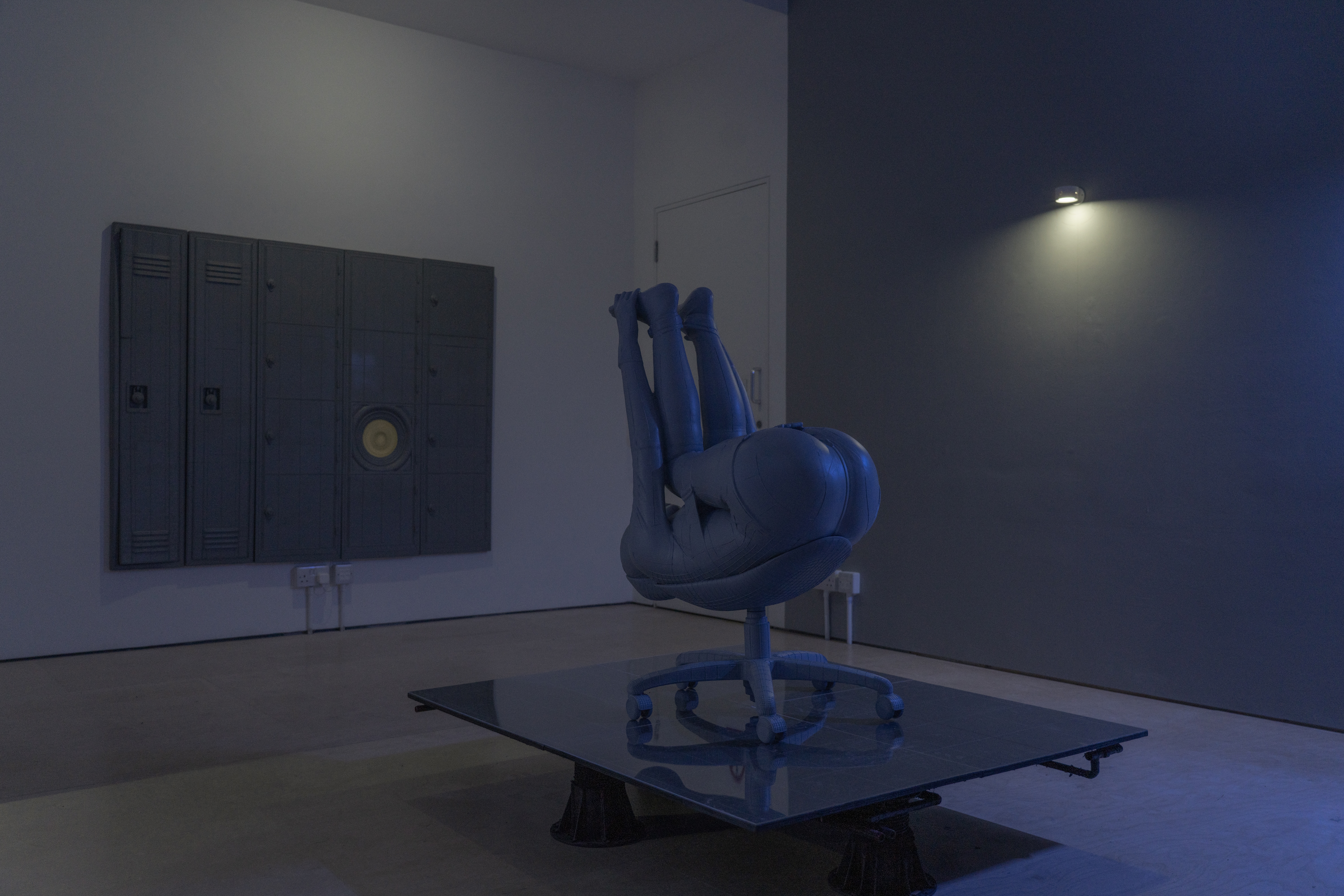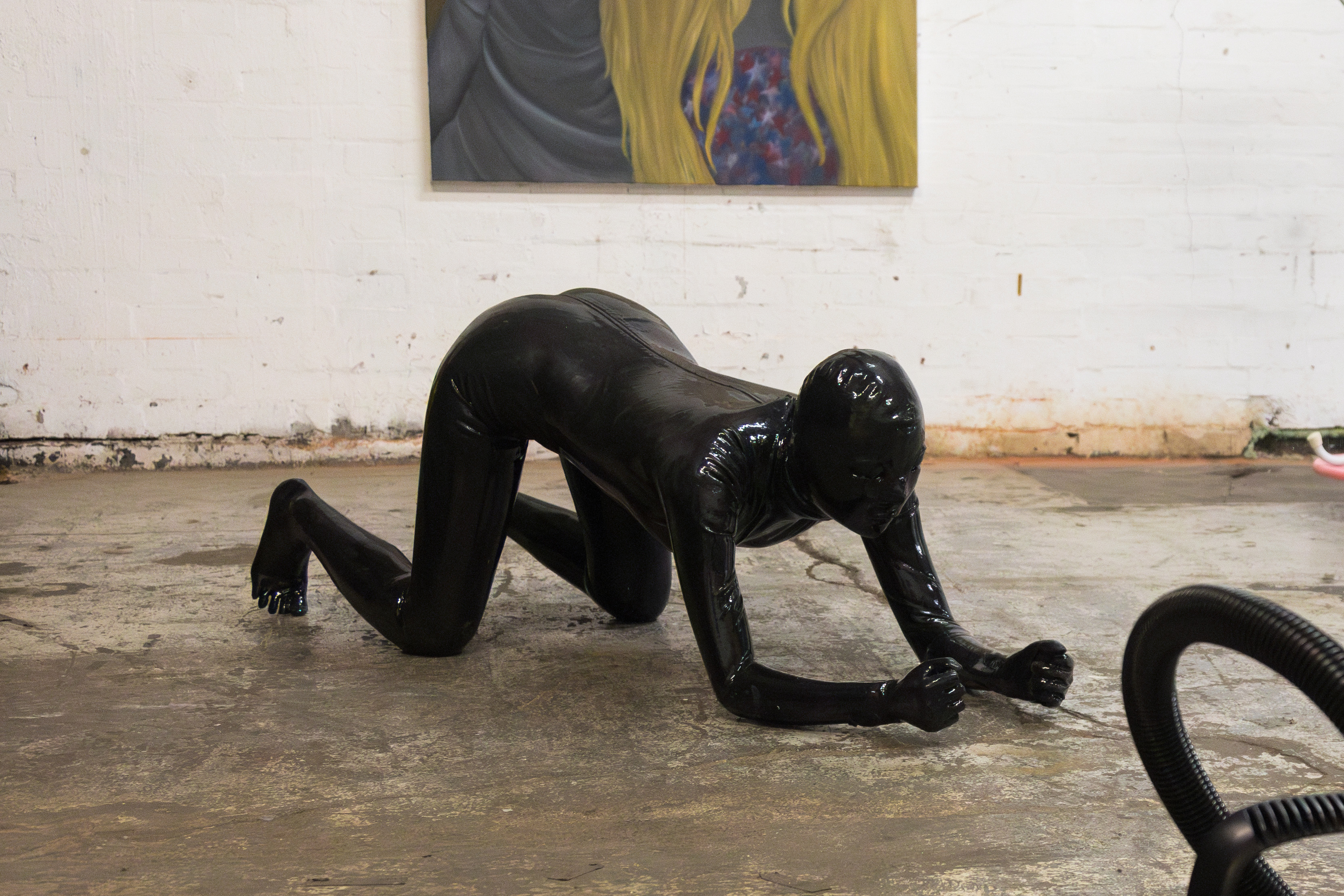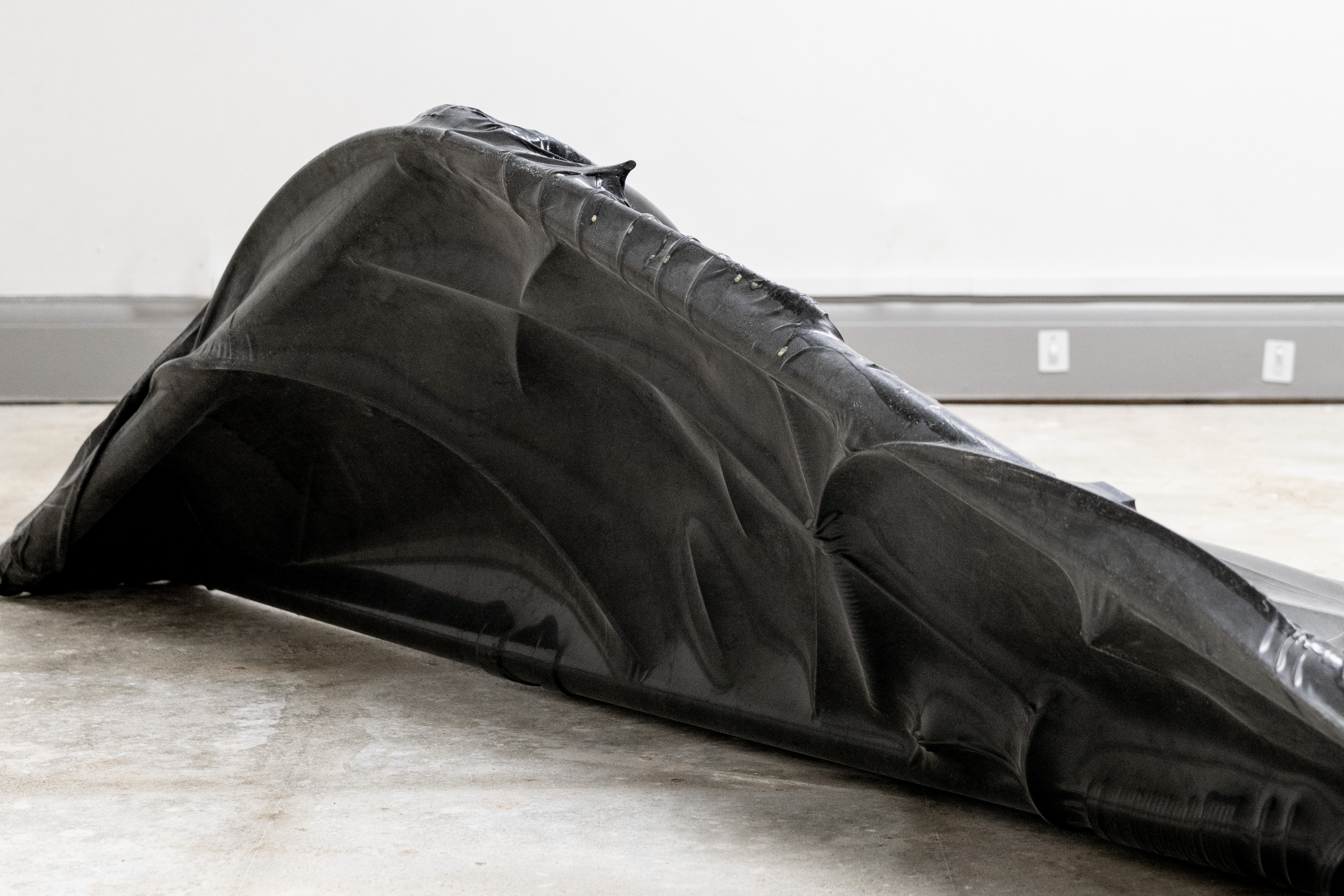Chaney Diao
-
Interview by Zhuyang Liu
-
Published in June 2025
-
A week before Chaney’s duo show opens at Seager Gallery in London, artist and friend Zhuyang paid a visit to her studio in London Fields. With several pieces still unfinished and others waiting to be packed for installation, they sat down amidst works-in-progress and open windows. Over the course of a few hours, what began as a casual studio visit unfolded into a dense conversation about objects, modelling, fantasy and the space between thinking and making.
-
Okay, I’m turning it on… I’ve never done this before with people I know. I wanted to start by asking you to introduce your new work - Headspace. I can see a bit here in the studio, but I'd love to know how it began.
Headspace is a word that holds a lot of meanings. On one level, there’s the everyday phrase - “I don’t have the headspace for this” - which talks about my own mental capacity, or bandwidth. But then it also becomes something more literal. Like an actual spatial zone inside the head. An inner furnace, almost. I think I want Headspace to live in that tension - between something psychological and something constructed. I’m trying to reflect on how physical space(s) and object(s) become mental, and how mental space can be materialised.

Mute, 2025. Photo courtesy of the artist
It’s interesting how Headspace works as both concept and method. You described it once as a framework, but not a fixed narrative. And I think that’s very present in the work - how things vibrate between physical and virtual, symbolic and practical. When I walked through the studio, I wasn’t sure if I was inside something complete or something still forming. And maybe that ambiguity is part of the point.
Yes, I think headspace deliberately resists resolution. I’m interested in layered narratives - what happens when something real overlaps with something projected. The feeling of vibration you mentioned comes from that stacking, that non-alignment. And that’s where 3D modelling reference came in - not just as a tool, but as a thought experiment.
In the past few months I was working with artist Li Yu on our art project DUMP for a video game called DUMP Doom Simulator, which “forced” us to 3D scan and remodel artists’ studios as part of the landscape for the game. This process enabled me to spend a long enough time with blender software to realise that when I model a space in the blender white, my brain already fills in the texture - may it be latex, cement, the color of a wall paper, or the carpet. But in that blender object view (white model), none of it is symbolised yet. It’s pure potential. The structure is there, but the meaning hasn’t settled. That in-between space started to feel like the most accurate way to describe what I was thinking.

The leather sofa you find sexy, 2025. Photo courtesy of the artist
I love that you called it a “white model” - like a mental prototype. You said your brain already knows what it’s going to be, but the viewer sees only the outline. There’s something generous in that - offering the structure but not the solution. It reminded me of how we both use modelling as a kind of sketch space. A way to hold contradictions without needing to resolve them. And it also opens the door to objectification - not in the surface sense, but in the way that bodies become containers or placeholders.
Yes. I do realise my interest in fetishism is more aligned to the idea of how people/a human body become objects. Particularly not in a way that’s about sexualising the body, but in that feeling of depersonalisation or objectification - which to me is very erotically charged.
The chair piece in this series came out of that logic. I try to make them always in direct reference to a specific BDSM act or fetish - which, take this new chair for instance, although is not the most publicly known BDSM practice, carries a nuanced duality that requires viewers’ own knowledge and perception to feed in.

Headspace [installation view], Seager Gallery, 2025. Photo courtesy of the artist
That made a lot of sense to me when I saw it. I remember saying to you that I also think a lot about objects becoming people and people becoming part of a room. I have this chair on my balcony - I've always meant to transform it into something else, a new instrument in my series - but I never did. I think we’re both interested in unresolved objects. Not as symbols, but as things that vibrate depending on who’s looking.
Totally. It’s that unresolved state I’m drawn to. The object doesn’t have to transform - it just needs to hold the possibility of transformation. That’s where it gains friction. The ambiguity is productive. It invites projection. And sometimes, something mundane becomes loaded because of the context. Like with the vacuum cleaner - originally, it was just a tool I had to use because the latex sculpture was leaking. But the more I thought about it, the more it made sense to keep it as a major element of my work. In DIY BDSM contexts, people literally use home vacuums to create pressure. It’s common. So suddenly, that object carried two logics - practical and erotic. And it worked both ways.
It’s that kind of slippage that I think about a lot too. I almost feel like it is a collapse. You don’t know who’s or what’s active anymore. And that’s where the charge is. You said once, “It’s not about the object. It’s about misalignment.” That stuck with me.
And that relationship becomes even sharper when you include the viewer. I remember standing in front of your chair piece and joking that I wanted to take off my pants. But actually, I meant it. Something about the work collapsed the social buffer, there’s a shorter viewing distance- closer social distance you are creating. It didn’t ask for anything, but it allowed for everything.
Exactly. I don’t want to force people to engage, but I want the possibility to be very present with my work. It waits. If you walk in, it doesn’t immediately try to explain itself. But if you stay, something starts to shift. And once you’re inside it, you can’t unfeel it. That’s the intimacy I’m after - not exposure, but quiet friction.
People’s engagement to your work and mine made me also wanna ask - Do you think everyone has been in a fantasy? As I really started to believe in this now.
Yeah, I think so too. I feel like it is very likely everyone’s living in a fantasy in their own way. Especially during and after the pandemic - it broke up time and made everything feel disconnected. We had to build our own structures to get through that. Even if it’s not a strong emotional fantasy, people are still constructing their own narratives to mundane life. Just to maintain some kind of internal continuity maybe?
Right. It’s not just about daydreaming or desire - it’s the scaffolding of how you live. And even those weird loops, like watching rich people shows or fantasising about other lifestyles, it becomes part of your psychic space. Some people are watching Buying Manhattan, and some are dreaming about moving to the mountains. It’s still a fantasy, even if it’s about someone else.
Exactly. And that’s something I also thought about in my practice. Like, I was watching this clip once - it was a behind-the-scenes of a porn shoot - and the use of the language is so similar to a line my teacher could have said to us as kids back in middle school. In the porn however, I feel like I was experiencing the flipping of this certains line because of how it is associated with the scenario now and the tone it is spoken out. I realised that same phrase, in another setting, would carry a totally different emotional weight. But maybe they used to carry exactly the same feeling to me that’s what made me into BDSM? Who knows? But I guess the main point is the more I reflect on this, the more I tend to think fantasy lives - not in content, but in shift. In how a space or gesture gets repurposed without warning.

In and out of sync, 2025. Photo courtesy of the artist
Yes! Like when a chair is in a studio, it holds one kind of meaning, but move it into a gallery or a furniture store, and it becomes something else. It’s not about what it is - it’s about how you read it!
Totally. And the viewer finishes the final meaning for it. It’s always changing depending on who’s looking and what they will bring. That’s what Headspace is trying to work through - how fantasy becomes a structure, and how that structure holds both clarity and confusion. A model, a vacuum, a latex fold. None of them mean anything on their own. But together, they form a kind of space you can fall into.
 Human stool, please sit, 2023. Photo courtesy of the artist
Human stool, please sit, 2023. Photo courtesy of the artistThis conversation feels like that too. We’ve gone from wireframes and chairs to vacuums and fantasy. Somehow it all holds together.
It really had to be through this interview that we finally unpacked so many common interests together!
I’m really glad we didn’t do this too late. I kept thinking — we should’ve done it earlier, but maybe this timing makes sense. I’ve been reflecting a lot recently on how some works just… fall out of relevance. Not because they stop being meaningful, but because the context shifts.
That’s been on my mind too. It feels like we are living in a very much accelerated reality that nothing will stay until a point to be classic to already be outdated. Having a background in fashion made me think alienation is a style now. Especially in fashion and the rate of change there is so fast. What’s in this season becomes ridiculous in six months. But that churn keeps the machine moving. It is almost saying the system needs disposal to stay current.

Dysfunctioned dec II, 2024. Photo courtesy of the artist
And art is catching up. Or maybe it’s already there. The churn is the same. One year it’s AI, the next it’s climate fiction, then it’s performance, or craft, or trauma. Everything gets theme-packaged. The market wants clarity, not confusion. But confusion is the space I want to stay in.
Like your BDSM chair. Some people think it’s absurd, some think it’s pornographic, some think it’s design. And all of them are right. It is disorienting. It breaks the space. I remember when I saw it, I just wanted to take off my pants. That social buffer collapsed. You’re rubbing my butt, you know?
[laughs] I really wonder what people would think about it this time haha.
[laughs] We’ll wait and see. We’ve talked about so many things - fantasy, context, friction -but I think underneath all of it is just a desire to stay in that flicker. That space where nothing fully lands, but everything is still charged. I think I’ll be thinking about this conversation for a long time.
Yah, me too. It is such a fun conversation.
Artist in the studio, Photo by Zhuyang Liu
-
chaneydiao.xyz/
︎ @chaney_dms
zhuyangliu.com/
︎ @zhuyangleiu
-
If you like this why not read our interview with Linnea Sköglosa.
-
© YAC | Young Artists in Conversation ALL RIGHTS RESERVED
